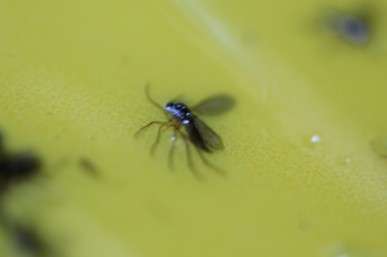Getting at the roots
If you are like me, you have house plants all over the place. In the summer they mostly live outside and do pretty well. But in the winter they come inside. And then there can be problems. One of the problems that I run into most often is fungus gnats.

Adult fungus gnat
Fungus gnats are flies (in the order Diptera). As adults they look like little mosquitoes, but as larva they live in the soil. While this is normal, it can become a problem in greenhouse and house plants where the feeding larva become concentrated. Although they feed on decomposing matter, they also damage roots. The larva pretty small, but you can still see them moving in the soil if there is a big enough infestation. They look like tiny clear worms.

Larval fungus gnat photo from http://www.ipm.ucdavis.edu/PMG/PESTNOTES/pn7448.html
These guys can cause issues for house plants. Wilting and stunting are common side effects of root damage. I like to keep track of populations in my house using yellow sticky traps. This way I know when fungus gnats are present and when their abundance starts to go up.

Yellow stick trap in a potted petunia
You can buy the yellow sticky traps on Amazon or at a garden store. They are basically sticky paper on a popsicle stick. As the adult fungus gnats emerge from the ground, they are attracted to the traps. They get stuck, thus preventing them from continuing to breed. If you put a trap in and get no insects, you don’t have fungus gnats. But if you, like my plant pictured above, get a bunch of them, then you might want to consider some management actions. From a distance the gnats look like little black dots on the trap. Up close they look like little flies with long legs.
 Fungus gnat stuck on a sticky trap
Fungus gnat stuck on a sticky trap
A very effective and safe method of dealing with fungus gnats is to introduce predatory nematodes. These are also available on Amazon and in many garden stores. Often they are called beneficial nematodes. Their are several species that are commercially available, and they should all work fine. They do need to be stored in a certain way and kept cold during shipping to be alive and effective.
Nematodes are a group of very small animals that are really all over the place: in the soil, in water, and in other animals. Some particular species attack insects in the soil, like fungus gnat larvae. I don’t have any good pictures of nematodes but Wikipedia does. After I introduced predatory nematodes into my indoor places, I stopped seeing any fungus gnats on my sticky traps. They are really very effective, as long as they are alive when put into the soil. If fungus gnats start showing up on the traps again, then add more nematodes!
Predatory nematodes are useful in larger agricultural situations as well. Plants grown in pots and in greenhouses, which are particularly vulnerable to fungus gnats, often benefit from continuous introduction of nematodes.

Trackbacks / Pingbacks